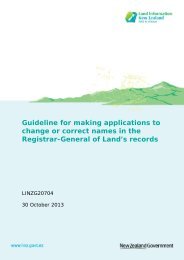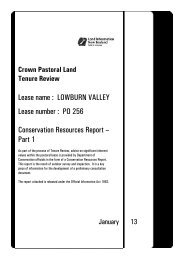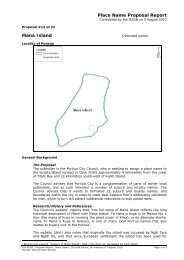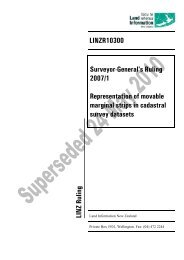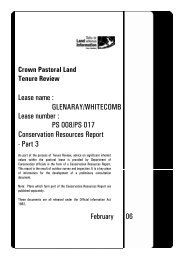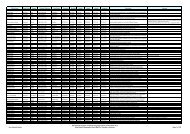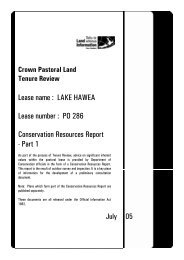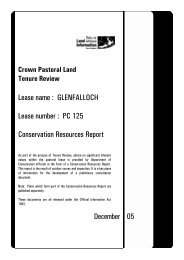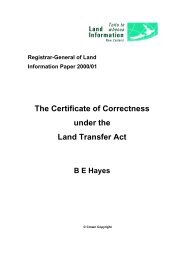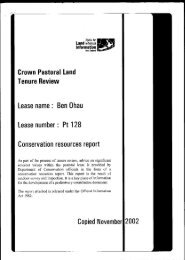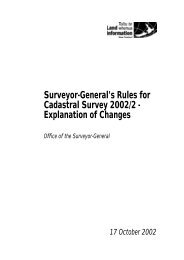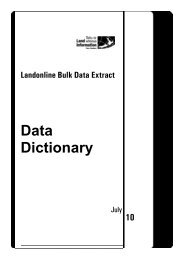Middle Hill Pastoral Lease - Land Information New Zealand
Middle Hill Pastoral Lease - Land Information New Zealand
Middle Hill Pastoral Lease - Land Information New Zealand
Create successful ePaper yourself
Turn your PDF publications into a flip-book with our unique Google optimized e-Paper software.
“RELEASED UNDER THE OFFICIAL INFORMATION ACT”<br />
Area 3, Wharekiri Stream<br />
This area covers the catchment of Wharekiri Stream at the southeast corner of the property.<br />
The Wharekiri Valley is almost entirely covered with indigenous woody vegetation. The<br />
northwest side of the valley (with the exception of the slopes near the mouth of the stream)<br />
supports kanuka scrub, kanuka forest, beech forest, beech-podocarp forest and hardwood<br />
forest. The southeast (drier) side of the valley supports kanuka scrub, kanuka shrubland and<br />
open rock on upper slopes and hardwood forest on lower slopes and in the main gullies.<br />
Areas of open grassland, shrubland and scrub are present on the main ridge to Batty, at the<br />
southeast boundary of the property.<br />
Older stands of taller kanuka have a diverse range of understorey and emergent species,<br />
including cabbage tree, lancewood, mountain totara, marbleleaf, Coprosma propinqua,<br />
Coprosma crassifolia, Coprosma rhamnoides, mahoe, kowhai, common broom,<br />
Helichrysum lanceolatum, native jasmine, bush lawyer, Clematis sp., akiraho, horopito,<br />
toetoe, mapou, broadleaf, mingimingi, Cyathodes fasciculata, tree nettle, prickly shield fern,<br />
Blechnum fluviatile, Blechnum chambersii, Asplenium richardii and Asplenium<br />
appendiculatum.<br />
Beech-podocarp forest is dominated by matai, totara, black beech, lancewood and pokaka.<br />
Other important species present are broadleaf, mahoe, lemonwood, Lophomyrtus obcordata,<br />
kanuka, mapou, weeping matipo, horopito, fivefinger, wineberry, marbleleaf, cabbage tree<br />
and climbing rata. Understorey species include tree fuchsia, Coprosma lucida, toetoe,<br />
Coprosma rhamnoides, Libertia sp., koromiko, tree tutu, hound’s tongue fern, Asplenium<br />
flaccidum, prickly shield fern, Pellaea rotundifolia, Asplenium richardii, Asplenium<br />
appendiculatum and a number of other ferns. Occasionally present are the tree ferns<br />
Dicksonia fibrosa and Cyathea dealbata.<br />
Hardwood forest is present on shady concave slopes and in gullies. It is usually dominated<br />
by several of the following species: mahoe, broadleaf, marbleleaf, kowhai, narrow-leaved<br />
lacebark, mountain ribbonwood, yellowwood, cabbage tree and mapou. Also commonly<br />
present are mountain totara, lemonwood, kaikomako, lowland ribbonwood and tall old<br />
kanuka trees. Areas of hardwood forest inspected were severely browsed. The very open<br />
understories support scattered plants of less palatable species such as horopito, tree nettle,<br />
Helichrysum lanceolatum, prickly shield fern and crown fern.<br />
Areas of beech forest were not surveyed on this part of the property, but appear to be (or<br />
have been) relatively extensive on the west side of Wharekiri Valley in the catchment of the<br />
main tributary stream near the southern boundary of the property. Relatively recent burning<br />
appears to have removed most areas of taller forest, but beech forest is regenerating strongly<br />
over much of the area.<br />
An area of diverse hardwood forest on the southeast-facing slopes of lower Wharekiri<br />
Stream is representative of the lowland forests that were formerly present on low-altitude<br />
hill slopes in the area. Dominant species are titoki, pigeonwood, broadleaf, mahoe, ngaio,<br />
kowhai, black maire, narrow-leaved lacebark and kanuka. Other important canopy or<br />
subcanopy species present are kaikomako, Coprosma areolata, tree tutu, lancewood,<br />
fivefinger, Lophomyrtus obcordata, cabbage tree, supplejack, tree fern (Dicksonia<br />
squarrose), marbleleaf, wineberry, mapou, tree fuchsia and young totara and matai.<br />
Understorey species include leafless lawyer, tree nettle, kawakawa, Coprosma lucida, native<br />
jasmine and the ferns Pellaea rotundifolia, Asplenium flaccidum, prickly shield fern,<br />
necklace fern, Blechnum chambersii, Adiantum cunninghamii, kiokio and Lastreopsis<br />
velutina. A scattered population of the threatened (sparse) fierce lancewood, including<br />
several young plants, is present at the northern end of this forest among dense Coprosma<br />
rhamnoides, Coprosma crassifolia and Helichrysum lanceolatum, beneath tall kanuka trees.<br />
CHCCO-70334 - <strong>Middle</strong> <strong>Hill</strong> CRR<br />
20-5-2005<br />
14



